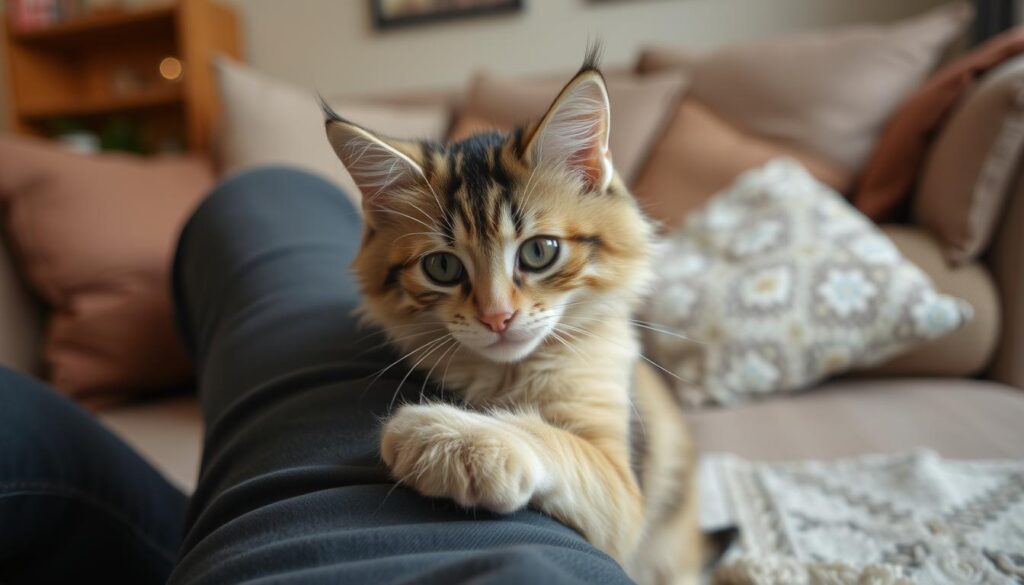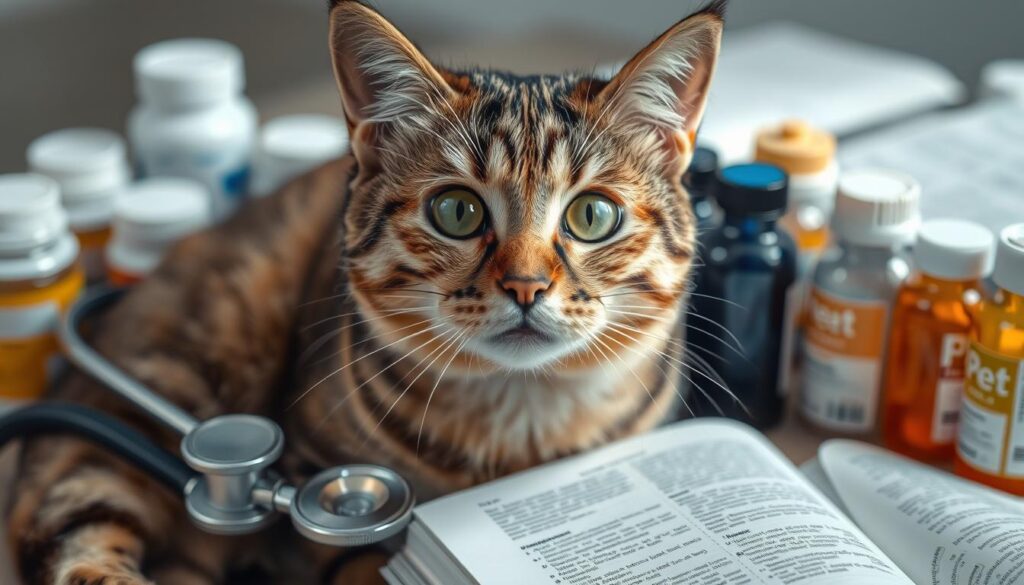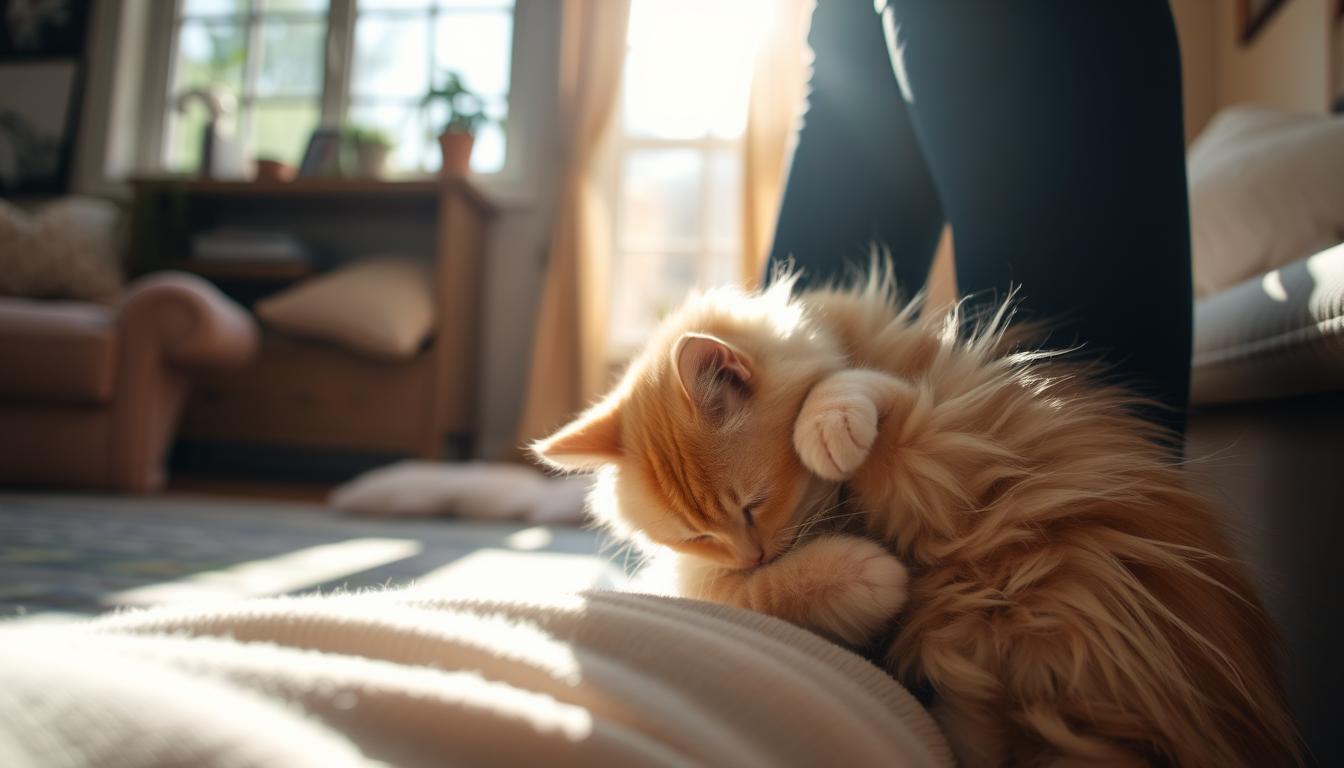Ever wondered why your cat rubs against your legs or face? It’s not just a sign of love. It’s a key part of how cats talk and mark their territory. Knowing why your cat does this can make you appreciate their special way of showing love and claiming their space.
Table of Contents
The Science Behind Feline Scent Communication
Cats have an amazing sense of smell, with over 200 million odor sensors. This makes smell their main way to understand and move around their world. They also have scent glands all over their bodies to help them smell better.
Understanding Cat Scent Glands
Cats have scent glands on their forehead, cheeks, chin, mouth, paw pads, and tail. These glands make pheromones, which are chemical signals. Cats rub against things to leave their scent and send messages.
The Role of Pheromones
There are three main pheromones in cats: F2 for mating, F3 for marking territory, and F4 for social bonding. These pheromones are key in cat communication. They help with mating, marking territory, and social interactions.
Olfactory Senses in Cats
Cats have a very sensitive sense of smell. They use it to learn about their surroundings and talk to other cats. By rubbing against things, cats leave their scent and send messages to other cats.
“Cats have over 200 million odor sensors, making their sense of smell their primary means of understanding their environment.”
Being able to communicate through scent is very important for cats. It helps them in their social lives and when they mark their territory.
Why Do Cats Rub Against You: The Primary Reasons
Cats have a special way to show their feelings, and rubbing against their owners is common. This simple action has many important meanings for cats. Knowing why they do this can help owners and cats bond closer.
One main reason cats rub against their owners is to mark their territory. They have scent glands in places like their cheeks and tail. Rubbing against you lets them leave their scent, making you part of their territory and social group. This helps cats feel connected in homes with other cats.
Cats also rub against their owners to show love and welcome. This behavior, called “head bunting” or “allorubbing,” shows their affection and trust. It’s a way for cats to bond with their humans and other cats too.
- Cats may rub against you to get attention and affection, showing signs of happiness.
- Rubbing can also help cats calm down when they’re stressed or anxious.
- Too much rubbing might mean there’s a health issue, like skin allergies or neurological problems. A vet should check this.
Understanding why cats rub against us helps us connect with them better. Whether it’s a greeting, a claim of territory, or a sign of love, this behavior is special. It makes our bond with cats deeper and more meaningful.
| Reason for Rubbing | Description |
|---|---|
| Territorial Marking | Cats have scent glands in various parts of their body, and rubbing deposits their scent, claiming you and your home as part of their territory. |
| Affection and Greeting | Head bunting and allorubbing are ways for cats to express fondness, trust, and social bonding with their human companions. |
| Attention-Seeking | Cats may rub against you to solicit attention and affection, often accompanied by purring or kneading behaviors. |
| Self-Soothing | Rubbing can be a calming, self-soothing behavior for cats, helping them to relieve stress or anxiety. |
| Medical Concerns | Excessive or obsessive rubbing behavior may be a sign of underlying medical issues, such as skin allergies or neurological problems. |
By understanding the reasons behind a cat’s rubbing behavior, pet owners can better interpret their feline’s needs and strengthen the bond between them. Whether it’s a greeting, a territorial claim, or a sign of affection, this behavior is a unique and meaningful form of communication that can deepen the human-cat relationship.
Head Bunting and Allorubbing Explained
Cats show many interesting social behaviors, like head bunting and allorubbing. Head bunting is when a cat bumps its head against someone or something. This happens in both home and wild cats. It helps them share scents, get closer, and feel part of a group.
The Significance of Head Bunting
Head bunting lets cats mark their territory and show they own people or things. They use glands in their cheeks to leave their scent. This way, they say they belong and feel close. It’s a big part of cat social behavior and feline bonding.
Social Bonding Through Allorubbing
Allorubbing is when cats rub against each other, usually in the same group. It helps them share scents and keep their bonds strong. Allorubbing helps cats strengthen their bonds and feel part of their group.
When Bunting Becomes Excessive
While head bunting and allorubbing are normal, too much bunting might mean health or stress issues. If your cat bunts too much or gets too clingy, watch them closely. Talk to a vet to find out why. This helps keep your cat happy and healthy, and keeps your bond strong.
“Cats have a unique way of expressing their affection and social needs through behaviors like head bunting and allorubbing. Understanding these behaviors can help us build stronger bonds with our feline companions.”
Territorial Marking Through Rubbing Behavior
Cats are very territorial and use rubbing to mark their territory. They rub against furniture, doorways, and even people. This leaves their scent behind, making them feel safe and secure.
Cats have scent glands in their paws, tail base, and cheeks. Rubbing against objects transfers these pheromones. This creates a scent that other cats can smell, making them feel at home.
Changes in the environment, like cleaning, can make cats rub more. They do this to mark their territory again. Punishing them for this can make them more stressed and anxious, leading to more rubbing.
Cats prefer to communicate through scent rather than sight. Their scent marks can tell other cats about their health and identity. Rubbing against you makes you part of their “family scent,” strengthening your bond.
Rubbing is a key part of a cat’s territorial behavior. Understanding this can help create a calm, familiar space for your cat. It can also make your relationship with them stronger and more trusting.
Expressing Affection and Building Trust
When your cat rubs against you, it’s a sign of love and a growing bond. This happens a lot after you’ve been apart, showing they’re happy to be with you. Knowing about feline body language helps you understand their feelings. It also makes your cat-human bond stronger.
Reading Your Cat’s Body Language
Cats show their feelings through body language. A tail held high and quivering means they’re happy and trust you. But a tail tucked under might show fear or doubt. The way their ears sit and where they look also tells you how they feel during cat affection.
Creating Emotional Bonds
When you respond well to your cat’s rubbing, like petting them gently or giving treats, it strengthens your bond. Doing mutual grooming, like brushing them, builds trust and connection too.
Signs of Trust and Comfort
- Cats sleeping on your lap or near you show deep trust and feel safe with you.
- Bringing you “gifts,” like a dead mouse, means they see you as part of their family and trust you.
- Showing their belly, a vulnerable spot, means they feel safe and comfortable with you.
Understanding your cat’s feline body language and responding positively to their cat affection helps build a stronger, more trusting relationship. This way, you and your cat can grow closer together.
The Connection Between Rubbing and Attention-Seeking
Cats show love and seek attention in many ways, like rubbing. Cat attention-seeking behavior includes rubbing against people or things in the house. This is how they talk to us about their feline communication and cat needs.
When cats rub against you, they’re showing love and wanting your attention. They might get treats, playtime, or go outside if they rub. It’s good to meet their needs, but also set limits, like not overfeeding to avoid obesity.
- Cats may rub against you to seek attention, food, or access to the outdoors.
- This behavior is often reinforced if it successfully leads to the desired outcome.
- It’s important to respond to your cat’s needs, but also maintain boundaries, especially regarding feeding schedules.

Cats are smart and know a lot about their world and the people in it. By rubbing against you, they’re asking for your time and love. It’s key to understand and answer these signals to strengthen your bond with your cat.
Understanding Different Types of Cat Rubbing
Cats show many different rubbing behaviors, each with its own meaning. They rub their faces, heads, bodies, and tails in various ways. Knowing these patterns can help you understand what your cat is trying to say.
Face and Head Rubbing Patterns
When your cat rubs its face and head on you, it’s a sign of love and marking. Cats have scent glands on their cheeks, chin, and forehead. By rubbing these areas, they leave their scent on you or things around them. This makes them feel safe and builds trust with their loved ones.
Body and Tail Rubbing Behaviors
Cats also rub their bodies and tails to greet, mark territory, or get attention. This rubbing can be a friendly move or a sign of their territorial nature. Watching your cat’s body language helps you understand what they mean by these actions.
Leg Weaving Patterns
Leg weaving is when cats wrap themselves around their owner’s legs. It’s a way for them to say hello or ask for attention. By doing this, they strengthen their bond with you and show they want to be close.
| Rubbing Behavior | Meaning |
|---|---|
| Face and Head Rubbing | Affection, Scent Marking |
| Body and Tail Rubbing | Greeting, Territorial Marking, Attention-Seeking |
| Leg Weaving | Greeting, Attention-Seeking |
Understanding cat rubbing behaviors helps you connect with your cat better. It strengthens the bond between you and your feline friend.
Medical Considerations and Warning Signs
Cats rubbing against their owners is usually a sign of affection. But, if they rub too much or too hard, it might mean they’re not feeling well. It’s important to watch for any changes in how they rub, as it could be a sign of cat health issues or feline medical concerns.
Things like allergies, fleas, ear infections, or even neurological problems might make a cat rub more. If your cat’s rubbing gets more intense or happens in new places, see a vet. They can check for any health problems.
A vet can find out what’s wrong and help your cat feel better. It’s key to fix the problem early to avoid more pain and stress for your pet.
Warning Signs to Watch For
- Sudden changes in rubbing behavior, such as increased frequency or intensity
- Rubbing against surfaces or objects more aggressively than usual
- Excessive grooming or licking, which may indicate skin irritation or allergies
- Presence of skin lesions, bumps, or other physical abnormalities
- Behavioral changes, such as increased vocalization, decreased appetite, or altered sleep patterns
Keep an eye out for any unusual signs and act fast if you see them. Your vet is there to help keep your cat healthy and happy. They can help with any cat health issues or feline medical concerns.

Building Stronger Bonds Through Physical Contact
Creating a strong bond with your cat is key for their happiness and yours. When your cat rubs against you, it’s a sign of affection. You can show love back by gently petting, softly talking, or playing together.
Cats rub against us to show love and mark their territory. By doing the same, you strengthen the cat-human bond. But always respect your cat’s personal space and only interact when they’re ready.
Regularly showing love through touch makes your cat feel safe and loved. This can lead to more affection from them, like head bunting and kneading. Understanding and responding to these behaviors can make your bond stronger and more rewarding.
Every cat is different, so it’s important to know what they like. Some cats love long petting sessions, while others prefer quick cuddles. Paying attention to your cat’s signals helps build a relationship based on trust and respect.
Building a strong bond through touch is a journey that benefits both you and your cat. By embracing their natural behaviors and showing positive reinforcement, you can create a lasting, meaningful connection.
The Role of Scent Marking in Multi-Cat Households
In homes with multiple cats, scent marking is key to keeping peace. Cats rub against each other and surfaces to share their scent. This creates a sense of community and can lower conflict.
Cats have scent glands on their cheeks, chin, paws, flanks, and tail base. Rubbing against surfaces and each other deposits their scent. This shared scent helps cats recognize each other as part of the same group. It strengthens their bond and reduces territorial fights.
To keep a peaceful home with multiple cats, provide enough resources. Make sure there are enough food, water, scratching posts, and toys. Also, give each cat their own litter box, with an extra one for peace of mind.

